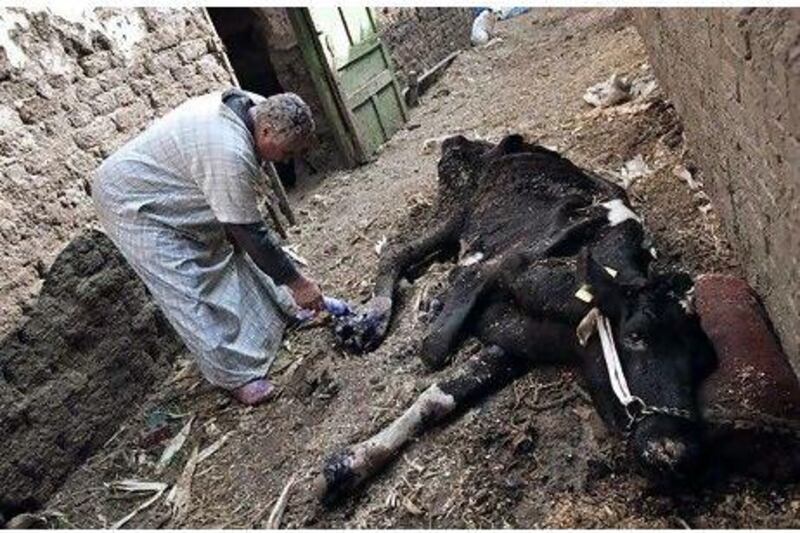Al Shawaye Al Malaq, Egypt // Freshly covered graves mask the carcasses of cattle felled by the foot-and-mouth disease outbreak spreading across Egypt, but farmers' frustration in the Nile Delta over the financial devastation is out in the open.
Al Shawaye Al Malaq is one of the worst hit villages in Egypt, with almost 5,000 livestock dead. Ahmed Ibrahim Ghayes lost all 20 of his calves and one adult cow; his remaining 59 cattle have all been infected.
With most of his cows either dead or unable to produce milk at capacity, Mr Ghayes's milk output has dropped 80 per cent. The outbreak has frozen the cattle trade, he said, making it difficult for him to pay off loans.
"No one is buying or selling cattle because everyone's afraid," he said.
Nearly 100,000 animals across Egypt have been infected, of which more than 9,000 have died, said the head of Egypt's central quarantine service earlier this week.
The United Nations Food and Agriculture Organisation (FAO) has warned the outbreak could threaten the whole of North Africa and the Middle East.
While the disease is not a direct threat to humans, meat and milk from sick animals are unsafe for consumption, raising concerns about food shortages.
The disease affects cloven-hoofed animals such as cows, buffalo, sheep, goats, and pigs. In Egypt, dairy and beef cattle, as well as buffalo, have primarily been affected.
The outbreak first appeared in Al Shawaye Al Malaq in early February and intensified in March. In early March, hundreds of cows were dying in a span of days but farmers say the number of deaths has dropped significantly.
The foot-and-mouth virus causes a high fever for two or three days, followed by blisters inside the mouth and on the feet that may rupture and cause lameness. There are outbreaks in Egypt every year, but this season the country has been hit with a strain that is unaffected by vaccines and animals' immunity.
The FAO has urged farmers to limit animal movements, stop purchasing new animals and properly dispose of carcasses by burning or burial. Egypt is not a major livestock exporter and the outbreak has not affected any other Egyptian export, according to Yilma Jobre, the team leader of the Emergency Centre for Transboundary Animal Diseases in the FAO's Egypt office.
But the government has struggled with the response in villages such as Al Shawaye Al Malaq, where animals live in close quarters and run through the streets.
Officials initially vaccinated for the usual strain of the disease, which quickly proved ineffective. When animals started dying, farmers dumped their carcasses on the side of the road.
"The government officials came to vaccinate the animals at the beginning of February, but the disease came afterward," said Fawziya, a villager whose family had eight cows fall ill and one die.The officials have not been back since, farmers said. Instead, locals learn of developments from news reports.
Many farmers said the government has not offered compensation for their dead livestock.
To gain the government's attention, residents took to dumping carcasses outside the local governmental veterinary office and blocking a nearby railway with burning tyres.
Yosri Al Banna, an employee at the Ministry of Justice whose family owns 27 cattle here, said the blame lies with top officials in Cairo.
"The veterinary workers here are great," Mr Al Banna said, but complained that the ministry officials do nothing but collect their salary.
All three of the Al Banna family's calves died in recent weeks. A sick cow sat in their backyard on Friday, its udders blistered and its mouth visibly infected.
"The government doesn't pay for anything," Al Banna's nephew Mustafa, 19, said.
The newspaper AlMasry AlYoum reported on Friday that pharmaceutical companies had made progress on finding an effective vaccine and that doses could be distributed to farmers throughout April.
The FAO has been providing technical assistance to the Egyptian government and has brought in international experts, said Mr Jobre.
But the government's help would most likely come too late for Tareq Al Khayat, a farmer in Al Shawaye Al Malaq. More than 15 of his cows and a buffalo were infected and three of his calves died. Of his 10 remaining calves, all were sick but were eating, which gave him hope they would live.
A very young calf, though, wobbled around its pen among the others. Unlike the rest, Mr Al Khayat said, it was weaning at the time of the outbreak and most likely contracted the disease from its mother's infected udders. Its mother lay in the next pen, its mouth, hoofs, and udders blistered and diseased.
Mr Al Khayat said his milk production has dropped by 70 per cent.
He and other farmers said the financial effect of the disease would long outlast the outbreak's two-month lifespan.
foreign.desk@thenational.ae






